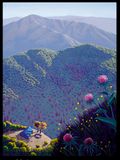Free Expression-Art
Yup’ik Masks (Photo Diary)
Native American Net Roots 11/20/2019
For the Central Alaska Yup’ik Eskimo, spirituality was focused largely on the need to secure food for hunting. As with other animistic hunting peoples, animals were felt to have souls which would be reincarnated. Thus, rituals sought to appease the soul of the animal so that it would give itself to the Yup’ik hunters who needed its meat.
Today, many museums consider Yup’ik masks to be works of art. Shown below are some of the Yup’ik masks which have been displayed in the Portland Art Museum and in the Maryhill Museum of Art.

Zombie flu: How the 1919 influenza pandemic fueled the rise of the living dead
In his story “Herbert West: Reanimator,” for example, Lovecraft creates a ghoulish doctor intent on reanimating newly dead corpses. A pandemic arrives that offers him fresh specimens – and that echoes the flu scenes of mass graves, overworked doctors and piles of bodies. When the head doctor of the hospital dies in the outbreak, Dr. West reanimates him, producing a proto-zombie figure that escapes to wreak havoc on the town. The living dead doctor lurches from house to house, ravaging bodies and spreading destruction, a monstrous, visible version of what the flu virus had done worldwide.
The first fairytales were feminist critiques of patriarchy. We need to revive their legacy
But this story is a myth. Fairytales were invented by the blue blood and pomaded sweat of a coterie of 17th century French female writers known as the conteuses, or storytellers......In the closing years of Louis XIV’s reign, French society had become dangerously religious and conservative. Prominent clerics argued for the banning of plays at Versailles, and art forms such as female-authored novels suffered increasing criticism.
